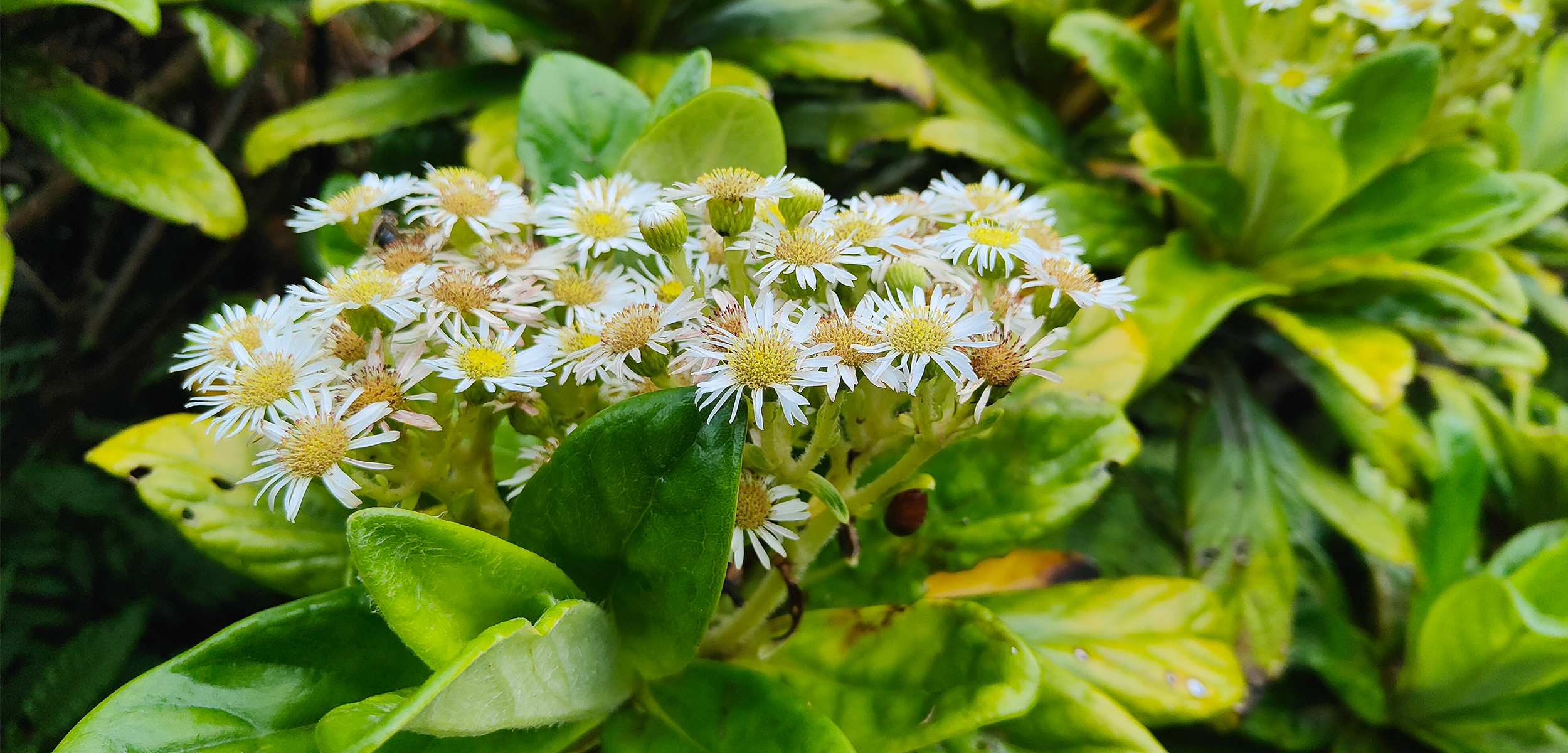Something Is Killing Saint Helena’s Cloud Forest
A deadly water mold—a relative of the pathogen that causes potato blight—is devastating what’s left of the South Atlantic island’s endemic trees.
Article body copy
Rebecca Cairns-Wicks looks up at the branches of a black cabbage tree. It’s growing at the edge of a grassy road along a sinuous ridge leading up the misty slopes of the cloud forest on Saint Helena Island. Umbels of small flowers, like bunched-up daisies, drape over the tree’s flat, leathery leaves, and a mat of ferns, lichens, mosses, and other organisms coat its trunk, giving it a strikingly black appearance.
“This tree is iconic,” says Cairns-Wicks, a plant geneticist and head of the St Helena Research Institute. Saint Helena—part of the British overseas territory Saint Helena, Ascension, and Tristan da Cunha, which lies more than 1,800 kilometers off the coast of West Africa, between Angola and Brazil—is known for its rare and beautiful cloud forest ecosystem, which is anchored by a variety of endemic cabbage trees with names such as whitewood, he cabbage, and she cabbage.
The first Portuguese sailors who landed on Saint Helena in the early 1500s found an island crowned with green, from its mist-covered peaks to its rocky shoreline. But 500 years of forestry, intensive farming, and destruction by introduced goats have wholly altered the island’s ecosystem. Two-thirds of the island is eroded and barren, and several species of endemic birds, invertebrates, and plants have gone extinct. At higher elevations, less than one percent of the island’s original cloud forest remains. And now, one of the world’s most feared plant pathogens, an invisible and deadly Phytophthora, seems intent on finishing it off.
Also known as water molds, many species of Phytophthora are killers. They thrive in waterlogged soils and can lurk for years until plants become stressed enough for them to strike. The world’s most notorious outbreak triggered the Irish potato famine of the mid-1800s. Another Phytophthora outbreak is currently threatening the global banana industry.
Although the pathogen is most obviously afflicting the island’s native trees, including the various cabbage trees, it’s affecting the whole forest ecosystem, says Cairns-Wicks. Any tree loss has a big effect, she says, not just on the landscape but also on the canopy cover. Already, “the canopy is shrinking. It’s affecting the light. It’s affecting the humidity and the temperature of the whole of the peaks.”
The stakes could not be higher says Rob Reeder, a plant pathologist with CABI, an international nonprofit organization focused on biodiversity conservation and sustainable agriculture projects. The trees dying on Saint Helena are, in some cases, among the last of their kind still growing in the wild. “All of the endemic trees on the island seem to be suffering,” he says. The risk of extinction is very real.
Over the past two years or so, scientists have been tracking how the Phytophthora is running through Saint Helena’s trees. Nobody’s quite sure how the pathogen got onto the island. But having evolved in isolation over millions of years, many of these trees—47 species found nowhere else on Earth—have no resistance to Phytophthora species, says Reeder. The water mold attacks the trees at their roots. While some trees simply melt into the landscape, others leave behind pale skeletons of leafless wood reaching for the sky.
So far, the grand old black cabbage tree that Cairns-Wicks pointed out, which may be 200 years old, has been spared. But researchers with CABI have found the Phytophthora throughout the cloud forest. Perhaps more concerningly, they’ve also found it in the island’s living seed bank and native plant nursery, where seedlings are grown by hand to be replanted on the peaks. Given how widespread it already is, eradicating the Phytophthora is nearly impossible, Reeder says. Once it enters the soil, “there’s no real means of getting rid of it. The only way of managing this thing is to stop it from spreading.”
While the tree die-off was first noticed two years ago, Reeder says the Phytophthora may have been lurking on the island for as long as a decade. Once it got established, he says, the water mold could have slowly spread around in surface-water runoff. There’s also the possibility the water mold was inadvertently spread by foot traffic, wildlife, or even the plant nursery.
Despite the difficult odds, Reeder says saving Saint Helena’s cloud forest is as crucial for the world’s botanical diversity as it is for the island’s cultural identity and tourism. And the local government is taking the problem very seriously. To protect the trees and prevent further Phytophthora spread, government officials have quarantined the island’s remaining cloud forest. It’s a decision that’s come at a cost to the island’s tourism industry, says Reeder.
CABI experts are also analyzing soil samples to understand just how widespread the water mold is, and using DNA analysis to try to identify the specific species of Phytophthora at play. If they can do these things, it might reveal other pathways to stop the pathogen’s spread.
Vanessa Thomas-Williams, who manages the island’s native plant nursery, says the nursery has also changed how it prepares its potting soil to prevent inadvertently spreading the pathogen even further.
Born on Saint Helena, Thomas-Williams refuses to accept defeat. “If I can get fertile seeds put into the [seed] bank, at least we can save them from extinction if the trees die,” she says. “This is what I’m dedicated to. I can’t let them die—not under my watch.”

